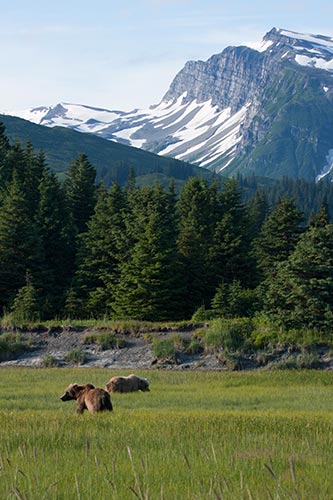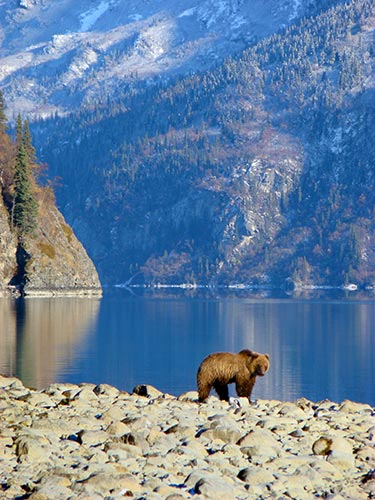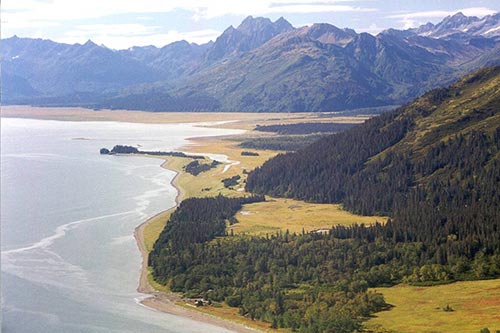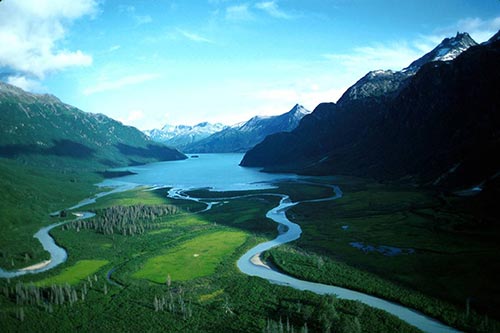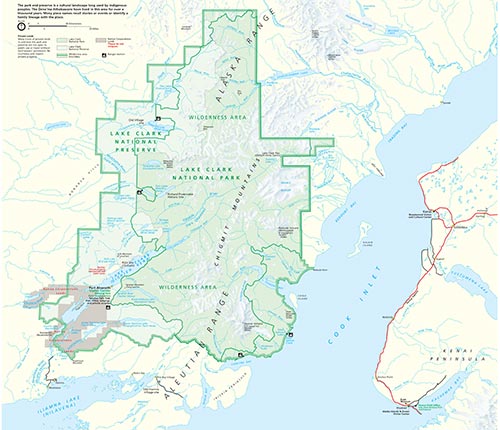Lake Clark National Park and Preserve
At a Glance
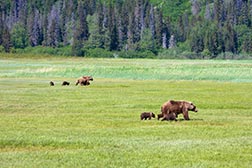
Both brown and black bears inhabit Lake Clark National Park, a vast wilderness that encompasses three mountain ranges, two volcanoes and a variety of ecosystems ranging from rainforest to alpine tundra. Many of the parks’ rivers, lakes, and tidal estuaries support the legendary Bristol Bay salmon runs and draw large concentrations of foraging bears. Black bears are found in most areas of the park except for higher elevations. Brown bears tend to concentrate along the coastline.
The park has very few amenities and infrastructure, so careful planning is important for prospective visitors. Though bigger than Rhode Island and Connecticut combined, the park has no roads, about seven miles of maintained trails, and 30 year-round employees. Access is mainly by floatplane, although the coastline along the southeast border of the park is also accessible by boat, weather and tides permitting.
Three areas that provide excellent bear viewing opportunities include Silver Salmon Creek, Chinitna Bay and Crescent Lake. At Silver Salmon Creek, on the Cook Inlet coast, brown bears can be seen grazing in sedge meadows, fishing or digging for razor clams on the beach. Coho (silver) and humpback (pink) salmon as well as Dolly Varden run up the creek in the late summer.
About 25 miles southwest of the creek is Chinitna Bay, which offers world class bear viewing along the beach, in upland meadows and in the rivers at the head of the bay when the salmon begin to run. Unique concentrations of food promote high numbers of bears foraging the protein rich sedges, clams, and salmon.
Crescent Lake, in the heart of the Chigmit Mountains, also offers outstanding opportunities to see bears. Sockeye and silver salmon run up the Crescent River throughout the summer. Brown and black bears travel the shoreline of the lake and river in search of their next meal. Crescent Lake is the park’s most popular destination.
Wherever you are, please respect the bears’ space and do not interfere with their activities. Bears depend on the fish and other food sources for their survival, especially over the long cold winter.
Facilities
The park is open year-round but most people visit between June and September. The visitor center, only open in summer, is located in Port Alsworth, a small community on the shores of Lake Clark. The visitor center is wheelchair accessible, and an all-terrain wheel chair—suited to the unpaved nature of Port Alsworth—is available for loan.
There are no fee areas in Lake Clark National Park and Preserve. Camping does not require reservations, and permits are not required for backcountry travel or camping. Please note: The National Park Service does not track your party's progress through the park. Staff recommends leaving a copy of your itinerary with a friend or relative for safety purposes.
The park is unimproved wilderness. A handful of ranger cabins scattered across the park are living quarters for park personnel and may or may not be staffed at any particular time over the summer.
Getting There
Lake Clark National Park and Preserve is not on the road system; therefore, access is primarily by small aircraft. A one to two-hour flight from Anchorage, Kenai or Homer will provide access to most points within Lake Clark. Fixed-wing aircraft are allowed to land on all suitable lakes, rivers, beaches, gravel bars, and open ground in both the Park and Preserve unless the area is closed or otherwise restricted. When weather and tides permit, the east side of the park on the Cook Inlet coast may be accessed by boat as well.
The park service web site maintains lists of commercial operators doing business in the park, including air taxi, boating, camping, photography, hiking, and bear viewing services. The website also has links to information about companies that rent gear and boats for independent travelers and about backcountry travel and camping in general. Links to this information can be found here: http://www.nps.gov/lacl/planyourvisit/gettingaround.htm
Contact Information
-
Port Alsworth Field Headquarters: (907) 781-2218
Monday - Friday 8:00am - 5:00pm
-
Port Alsworth Visitor Center: (907) 781-2117 (or 781-2118 in winter)
Call for current hours.
-
Anchorage Administrative Headquarters: (907) 644-3626
Monday - Friday 8:00am - 5:00pm
-
Homer Field Office: (907) 235-7903 or (907) 235-7891
Monday - Friday 8:00am - 5:00pm
-
Email the park for information at: lacl_visitor_information@nps.gov
-
Lake Clark National Park website
Gallery
